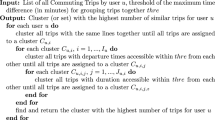Abstract
GPS enabled devices, generating high-resolution spatial–temporal data, are opening new lines of possibilities for transportation applications in both planning and research. Mining these rich and large datasets to infer people’s travel behavior, the activity patterns resulting from their behavior, and allocating activities in the network is the focus of this paper. Here we introduce a methodology that relies only on geocoded location data and socioeconomic characteristics to infer types of activities in which individuals engage at different locations in the network. Depending on the duration of the stop, arrival time and geographic distance to home location and previous activities, the type of activity is inferred at the census tract level using adaptive boosting algorithm. Then, using a model based on Markov chains with conditional random field to capture dependency between activity sequencing and individuals’ socioeconomic attributes, the spatial–temporal trajectory of activity/travel engagement is generated. The model is trained on data obtained from the California Household Travel Survey data 2000–2001 and subsequently applied to an out-of sample test set to validate the accuracy and performance.







Similar content being viewed by others
References
Agrawal, R., Srikant, R.: Mining sequential patterns. In: Proceedings of the Eleventh International Conference on Data Engineering, IEEE Computer Society Press, pp 3–14 (1995). doi:10.1109/ICDE.1995.380415
Allahviranloo, M., Jeliazkov, I.: Bayesian analysis of personal daily activity patterns. In: 93rd Annual Meetings of Transportation Research Board of the National Academies, (2013)
Allahviranloo, M., Recker, W.: Daily activity pattern recognition by using support vector machines with multiple classes. Transp. Res. B Elsevier Ltd 58(December), 16–43 (2013). doi:10.1016/j.trb.2013.09.008
Bishop, C.M.: Pattern Recognition and Machine Learning. Springer, Heidelberg (2006)
Bohte, W., Maat, K.: Deriving and validating trip purposes and travel modes for multi-day GPS-based travel surveys: a large-scale application in the Netherlands. Transp. Res. Part C 17(3), 285–297 (2009). doi:10.1016/j.trc.2008.11.004
Caltrans.: California Statewide Household Travel Survey. California Statewide Household Travel Survey Final Report. vol. 78746. California Department of Transportation (2002)
Cao, X., Cong, G., Jensen, C.S.: Mining significant semantic locations from GPS data. Proc. VLDB Endow. 3(1–2), 1009–1020 (2010). doi:10.14778/1920841.1920968
Cheng, Z., Caverlee, J., Lee, K., Sui, D.Z.: 2011. Exploring millions of footprints in location sharing services. In: Fifth International AAAI Conference on Weblogs and Social Media, 2010, pp 81–88
Forrest, T.L., Pearson, D.F.: Comparison of trip determination methods in household travel surveys enhanced by a global positioning system. Transp. Res. Rec. J. Transp. Res. Board 1917, 63–71 (2002)
Giannotti, F., Nanni, M., Pedreschi, D., Renso, C., Trasarti, R.: Mining mobility behavior from trajectory data. In: 2009 International Conference on Computational Science and Engineering, IEEE, pp. 948–951 (2009). doi:10.1109/CSE.2009.542
Giannotti, F.: GeoPKDD geographic privacy-aware knowledge discovery and delivery (2009)
Giannotti, F., Nanni, M., Pedreschi, D., Pinelli, F., Renso, C., Rinzivillo, S., Trasarti, R.: Unveiling the complexity of human mobility by querying and mining massive trajectory data. VLDB J. 20(5), 695–719 (2011). doi:10.1007/s00778-011-0244-8
Gidófalvi, G., Pedersen, T.B.: Spatio-temporal rule mining. In: Proceedings of Data Warehousing and Knowledge Discovery Conference, 2005, pp. 275–284. Springer, Berlin (2005)
Hato, E.: Development of behavioral context addressable loggers in the shell for travel-activity analysis. Transp. Res. C 18(1), 55–67 (2010). doi:10.1016/j.trc.2009.04.013
Keuleers, B., Wets, G., Timmermans, H., Arentze, T., Vanhoof, K.: Stationary and time-varying patterns in activity diary panel data explorative analysis with association rules. Transp. Res. Rec. 1752, 9–15 (1998)
Kusakabe, T., Asakura, Y.: Behavioural data mining of transit smart card data: a data fusion approach. Transp. Res. Part C 46, 179–191 (2014). doi:10.1016/j.trc.2014.05.012
Laube, P., Purves, R.S.: An approach to evaluating motion pattern detection techniques in spatio-temporal data. Comput. Environ. Urban Syst. 30(3), 347–374 (2006). doi:10.1016/j.compenvurbsys.2005.09.001
Liao, L.: Location-Based Activity Recognition. University of Washington, Seattle (2006)
Liao, L., Fox, D., Kautz, H.: Extracting places and activities from GPS traces using hierarchical conditional random fields. Int. J. Robot. Res. 26(1), 119–134 (2007). doi:10.1177/0278364907073775
Oliver, M., Badland, H., Mavoa, S., Duncan, M.J., Duncan, S.: Combining GPS, GIS, and accelerometry: methodological issues in the assessment of location and intensity of travel behaviors. J. Phys. Act. Health 7(1), 102–108. http://www.ncbi.nlm.nih.gov/pubmed/20231761 (2010)
Quercia, D., Hare, N.O., Cramer, H.: Aesthetic capital: what makes London look beautiful, quiet, and happy? In: Computer-Supported Cooperative Work, Maryland, USA, 2014
Schuessler, N., Axhausen, K.W.: Processing raw data from global positioning systems without additional information. Transp. Res. Rec. J. Transp. Res. Board 2105(1), 28–36 (2009). doi:10.3141/2105-04
Shafique, M.A., Hato, E.: Use of acceleration data for transportation mode prediction. Transportation (2014). doi:10.1007/s11116-014-9541-6
Shen, L., Stopher, P.R.: A process for trip purpose imputation from global positioning system data. Transp. Res. Part C 36, 261–267 (2013). doi:10.1016/j.trc.2013.09.004
Wagner, D.P.: Lexington Area Travel Data Collection Test. Federal Highway Administration, U.S. Department of Transportation, Columbus (1997)
Ye, Y., Zheng, Y., Chen, Y., Feng, J., Xie, X.: Mining individual life pattern based on location history. In: 2009 Tenth International Conference on Mobile Data Management: Systems, Services and Middleware, 2009, pp. 1–10. IEEE. doi:10.1109/MDM.2009.11
Zheng, Y., Zhang, L., Xie, X., Ma, W.-Y.: Mining interesting locations and travel sequences from GPS trajectories. In: Proceedings of the 18th International Conference on World Wide Web—WWW’09, New York, p. 791. New York: ACM Press, 2009. doi:10.1145/1526709.1526816
Zheng, V.W., Zheng, Y., Xie, X., Yang, Q.: Towards mobile intelligence: learning from GPS history data for collaborative recommendation. Artif. Intell. 184–185, 17–37 (2012). doi:10.1016/j.artint.2012.02.002
Acknowledgments
Anonymous reviewers of the paper are gratefully acknowledged for their valuable comments. This research was supported, in part, by a grant from the University of California Transportation Center.
Author information
Authors and Affiliations
Corresponding author
Rights and permissions
About this article
Cite this article
Allahviranloo, M., Recker, W. Mining activity pattern trajectories and allocating activities in the network. Transportation 42, 561–579 (2015). https://doi.org/10.1007/s11116-015-9602-5
Published:
Issue Date:
DOI: https://doi.org/10.1007/s11116-015-9602-5




